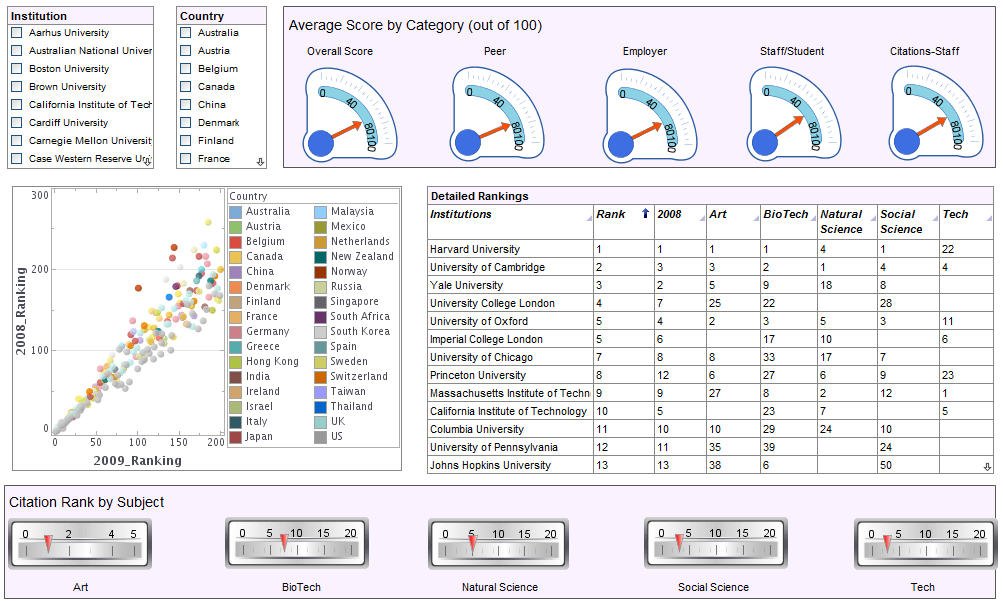InetSoft's Education Dashboard Software
Searching for education dashboard software with automated data monitoring and report generating functionality to use with existing systems? InetSoft's dashboard software is easy to deploy and use and offers a highly interactive and customizable design.
InetSoft's dashboarding software is robust enough to:
- grab the attention of executives
- meet the demands of power users
- scale up for organizations of all sizes
and is easy enough to be:
- deployed in weeks, not months
- learned by end-users with minimal training
and flexible enough to:
- adapt to changing data structures and business needs
- accommodate data exploration through visualization and maximum self-service
What KPIs Should Be on an Education Dashboard?
Schools and universities face a daunting challenge in assessing and enhancing student performance as the education sector changes over time. To make sure they are providing high-quality instruction and meeting the expectations of students, parents, and other stakeholders, they must monitor a number of metrics.
An education dashboard that shows key performance indicators (KPIs) to track student growth, teacher efficacy, and institutional success may be a solution to this problem. We will discuss the KPIs to include on an education dashboard in this post as well as their significance to the education industry.
What is an Education Dashboard?
A tool that offers a thorough overview of the functioning of the educational institution is a dashboard for education. It enables instructors, school leaders, and other interested parties to keep tabs on students' development, spot patterns, and make data-driven choices. KPIs that measure the success of educational institutions, such as academic accomplishments, student conduct, teacher performance, and institutional effectiveness, are often shown in education dashboards.
Why Is a Dashboard for Education Important?
For a number of reasons, educational institutions need an education dashboard. They are able to:
Monitor and improve student performance:
Education dashboards assist schools and institutions in keeping track of their students' academic achievement, identifying areas for development, and creating plans to improve student performance.
Detect and resolve student behavior problems:
Education dashboards assist schools in recognizing and resolving student behavior problems. Schools may intervene early and stop undesirable conduct from having an impact on academic achievement by measuring measures like attendance, tardiness, and disciplinary actions.
Enhance teacher performance:
Schools may use education dashboards to find and assist teachers who might require more resources or training in order to perform better. Schools can identify instructors who may be having difficulties and provide them the help they need by measuring measures like student ratings and student progress.
Improve institutional efficacy:
By monitoring measures like graduation rates, student retention rates, and alumni employment rates, education dashboards may assist educational institutions in evaluating their overall success. Schools may improve their institutional performance by tracking these measures and identifying areas that need improvement.
What Educational KPIs to Track?
KPIs for Student Achievement:
Student academic progress is monitored by student accomplishment KPIs. Common Goals for student success include:
a) Grade Point Average (GPA): A student's grade point average (GPA) is a gauge of their general academic success. It is determined by average the student's grades across all of their courses.
b) Standardized Test Scores: Standardized test scores from tests like the SAT, ACT, and AP provide an unbiased assessment of a student's intellectual aptitude.
b) Course Completion Rate: The proportion of students who successfully finish a course is reflected in the course completion rate.
d) Retention Rate: The proportion of students who return to the institution for the next academic year is measured by the retention rate.
KPIs for Student Behavior
KPIs for student conduct keep tabs on how they behave in the classroom and around campus. Many typical KPIs for student conduct include:
a) Attendance Rate: Attendance rate measures the percentage of students who attend classes regularly.
b) Tardiness Rate: This statistic represents the proportion of students who regularly arrive late for class.
c) Disciplinary Actions: Disciplinary actions keep track of the number of sanctions applied to pupils who break school regulations.
d) Student Engagement: Students' levels of participation and involvement in the classroom and on campus are measured by their degree of engagement.
Teacher Performance Metrics:
KPIs for teacher performance monitor how well instructors are doing in the classroom. Common key performance indicators for teachers include:
a) Student assessments: From the viewpoint of the students, student evaluations gauge the performance and pleasure of instructors.
b) Teacher Attendance Rate: This statistic represents the proportion of instructors who routinely show up for work.
c) Classroom Observations: Classroom observations evaluate how well instructors deliver lessons, supervise their pupils, and provide them feedback.
d) Professional Development: Professional development gauges how actively instructors participate in learning and development initiatives.
KPIs for Institutional Effectiveness:
Institutional performance KPIs monitor the educational institution's general efficacy. Typical institutional effectiveness KPIs include the following:
a) Graduation Rate: Graduation rate measures the percentage of students who graduate from the institution.
b) Student Retention Rate: This statistic represents the proportion of students who remain enrolled in the school throughout their academic careers.
b) Alumni Employment Rate: This statistic represents the proportion of graduates who find work following graduation.
d) Student Satisfaction: This metric gauges how happy students are with the school, its services, and its programs.
Additional Considerations for KPI Selection
The aims and objectives of your school must be taken into account when selecting the appropriate KPIs for your education dashboard. While choosing KPIs, some things to keep in mind are as follows:
- Relevance: The KPIs you select should be pertinent to the aims and objectives of your institution. They need to provide perceptions into the topics that are most important to your organization.
- Data Availability: The KPIs you select should be based on data that is easily accessible and able to be gathered.
- Availability of Data: The KPIs you choose should be based on data that is readily available and can be collected easily.
- Actionable: The KPIs you choose should be actionable. They should provide insights that can be used to make informed decisions and take action to improve performance.
- Consistency: Your chosen KPIs need to be constant. In order to make sure that data is comparable and patterns can be found, they should be applied consistently across time.




